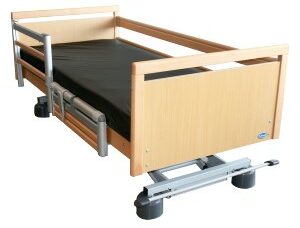As the population ages, the demand for comfortable and practical solutions for elderly care continues to rise. One crucial aspect of eldercare is the choice of beds, with adjustable options gaining popularity. Adjustable home hospital beds are better for elderly patients than regular adjustable beds. In this blog, we’ll discuss why adjustable beds are important for elderly people who need special care.
1. Medical Grade Design and Features
Designers create adjustable home hospital beds for elderly patients, including features that meet their medical needs. Hospital beds have side rails, easy controls, and special mattresses, unlike regular adjustable beds. These beds are made for elderly people to be safe and comfortable, preventing accidents and improving sleep.
Including side rails on hospital beds is a crucial safety feature, especially for seniors prone to falls. These rails provide support when getting in and out of bed and prevent accidental falls during the night. Hospital beds have adjustable height settings, which help caregivers assist elderly patients and reduce strain on their backs.
Hospital beds have controls that make it easy to adjust the bed position, either using a hand pendant or staff control on the foot sections. This is good for older people who have trouble moving or have health problems like arthritis. It helps them find a comfortable position in bed without needing help from caregivers.
2. Enhanced Comfort and Pressure Relief
Adjustable home hospital beds go beyond the standard features of adjustable beds by offering enhanced comfort and pressure relief. Older individuals frequently experience health issues such as arthritis, back pain, and breathing difficulties. These conditions can worsen if they sleep in an improper position. Hospital beds have special mattresses like memory foam or air mattresses to give the best support and relieve pressure.
These specialized mattresses help distribute body weight evenly, reducing pressure on specific areas prone to discomfort or pain. This is crucial for older patients who may be bedridden because of illness or mobility issues. Staying in bed for extended periods can have significant implications for their well-being. Hospital beds improve sleep quality and well-being for elderly people by providing more comfort and pressure relief.
3. Mobility and Accessibility
Elderly patients often face challenges related to mobility and accessibility. Adjustable beds for home hospitals help patients and caregivers with daily tasks by providing helpful features. The bed’s adjustable height feature is a key factor in enhancing their mobility.
Adjusting the bed’s height makes it easier for the user and caregiver to move the person. This minimizes the risk of injuries associated with lifting or assisting patients, promoting a safer caregiving environment. The adjustable height helps elderly patients get in and out of bed by themselves, promoting independence.
4. Versatility for Various Health Conditions
Adjustable home hospital beds are versatile and can accommodate various health conditions commonly experienced by elderly people. You can adjust a hospital bed to suit different medical needs, like breathing problems, circulation issues, or post-surgery recovery.
Hospital beds can tilt to help with blood flow and breathing, like Trendelenburg and reverse Trendelenburg positions. These can raise and lower the head and foot section diagonally. These positions can help elderly patients with heart conditions, breathing disorders, or those recovering from surgery.
Hospital beds are versatile and can change to meet the changing health needs of older people. They offer more personalized care than regular adjustable beds.
5. Built-In Assistance for Caregivers
Caring for an older family member can be physically challenging. However, having adjustable beds at home can make it easier for caregivers. The bed’s adjustability and additional functionalities simplify daily caregiving tasks, reducing strain and potential injuries.
Hospital beds can have alarms that tell caregivers when someone tries to exit the bed. This is especially important for those with cognitive impairments or a tendency to wander.
Caregivers and patients can adjust the bed can bed with a button. This makes it easier for caregivers to help without needing to make difficult manual changes.
Choosing between a home hospital bed and a regular adjustable bed is crucial for elderly patients. This decision impacts their comfort, safety, and overall well-being. Adjustable home hospital beds are the best option for elderly care. They have a medical-grade design, are comfortable, accessible, versatile, and provide built-in assistance for caregivers.
Investing in specialized beds improves the lives of elderly people and gives peace of mind to their caregivers.
Comparison Chart / Summary
ADJUSTABLE HOSPITAL BED | STANDARD ADJUSTABLE BED |
|---|---|
| POSITIONING | |
| Adjustable backrest, leg rests, overall height and bed tilt (Trendelenburg) | Adjustable backrest and leg rests |
| COMFORT FEATURES | |
| Compatible with pressure prevention and low air loss mattresses | Uses a lifestyle, flexible foam mattress. Not compatible with air mattresses |
| SAFETY FEATURES | |
| Optional integrated full and half bed rails and ultra low height for fall prevention | Aftermarket static rails |
Book an Appointment Today
Interested in experiencing the comfort and ease of our adjustable home hospital beds? We invite you to book an appointment to visit our store and get a demo. This is a great opportunity to find the perfect adjustable hospital bed tailored to your needs.

















